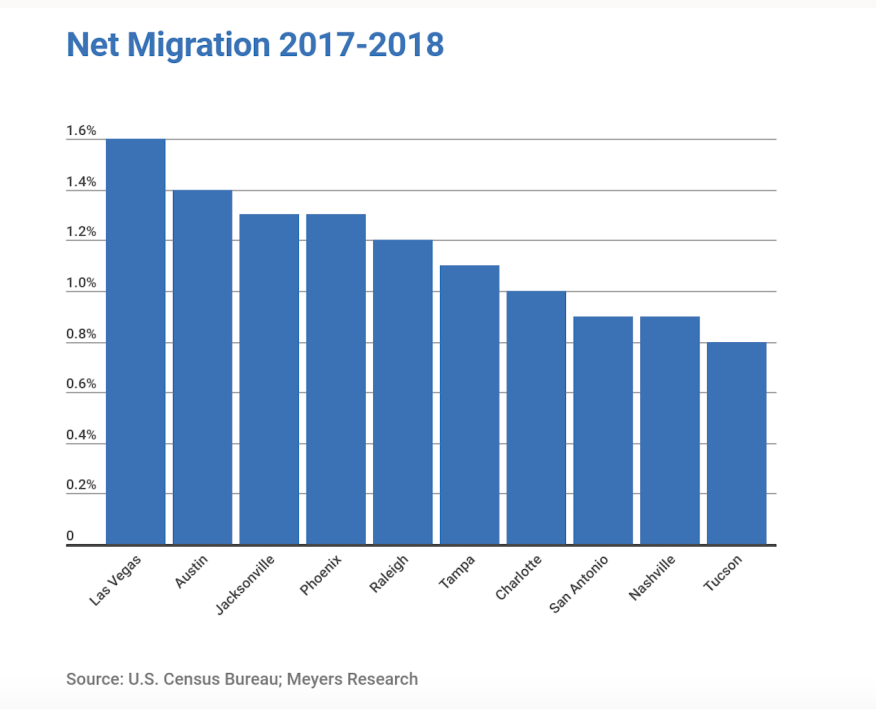Preparing Now For The Next Housing Uptick

Interesting article published on builderonline.com discussing In- and out-migration trends that matter most to home builders, residential developers, and investors planning for 2023 and beyond. Read more at:
https://www.builderonline.com/land/local-markets/preparing-now-for-the-next-housing-uptick_o
Of the ten markets with the most positive domestic net migration*:
- All are in more southern states, with Nashville being the northern-most point
- 50% are on the East Coast
- Texas, Florida, Arizona, and North Carolina are home to two of the top ten each
- Phoenix, the fourth highest for net migration, is the largest as the 11th most populous metro in the country. Tucson, the other Arizona market, broke into the top 10 for net migration this year and is the smallest, landing as the 53rd most populous metro in the US.
Here are some take-aways from data analyzed by Meyers Research director of economic research Ali Wolf, concluding:
Las Vegas, Austin, and Jacksonville hold the top spots for positive net migration and are also among the top performing housing markets so far this year.
Las Vegas is the new #1. Las Vegas has been in the top ten for positive net migration since 2013 gradually moving up. For 2018, Las Vegas bumped Austin, the reigning champ for five consecutive years, down to the second spot. Las Vegas averages about 100 people moving to the metro a day and Redfin search data suggests the new residents are coming mostly from the West Coast, including Los Angeles, the Bay Area, and Portland. This contributed to Las Vegas having one of the best average sales rates per community in 2019, at 3.06, according to Zonda.
Austin hits the relative affordability sweet spot. Austin’s new home communities have the biggest year-over-year jump in average sales rate among top markets year-to-date, up 19% from the same period in 2018. The average new home list price in the metro of $328,000 is 26% higher than the average of the 10 best-selling new home communities over the past three months. In the metro, nearly 61% of households can afford the median-priced new home, a relatively high percentage compared to other top markets due, in part, to two reasons:
- Inbound Austin residents are from expensive coastal cities like New York, DC, Seattle, Los Angeles, and the Bay Area.
- The metro leads the nation in business service job count, up 37% since 2012. These jobs tend to be highly paid.
Jacksonville’s fourth year in the top 10. Jacksonville first appeared on the list four years ago at the fifth spot before moving up to number three last year. The market averages nearly 60 people moving in a day, up 6% from last year. Like Austin, this trend has aided Jacksonville to a place amongst the biggest growth markets year-to-date with an average sales rate of 1.82 per community, up 8% YOY.
WINNERS (AND SOME LOSERS) OF MIGRATION TRENDS
The data allows for trends to be seen in multiple categories, including daily, international, and negative net migration. Here are some other notable takeaways from the newly released stats:
- Consistently in the top 10. 50% of the top net migration markets have been the same over the past six years, including Austin, Raleigh, Nashville, San Antonio, and Charlotte. Orlando, Las Vegas, and Tampa have made the list five out of six times.
- Most daily net migration. Dallas and Phoenix have had the highest daily net migration over the past three years. Tampa held the third spot the past two years before Las Vegas bumped it to fourth last year.
- Top international locations. The inbound international locations have barely changed over the past six years with Miami, San Jose, Orlando, DC, San Francisco, Boston, Seattle, and Houston making the top ten every year. Tampa moved into the top ten for the first time last year, pushing New York out.
- Negative net migration. San Jose, New York, Miami, LA, and Chicago are seeing the biggest negative net migration trends. New York is losing 600 people on average per day, LA: 300, Chicago: 230, Miami: 130, and San Jose: 70.